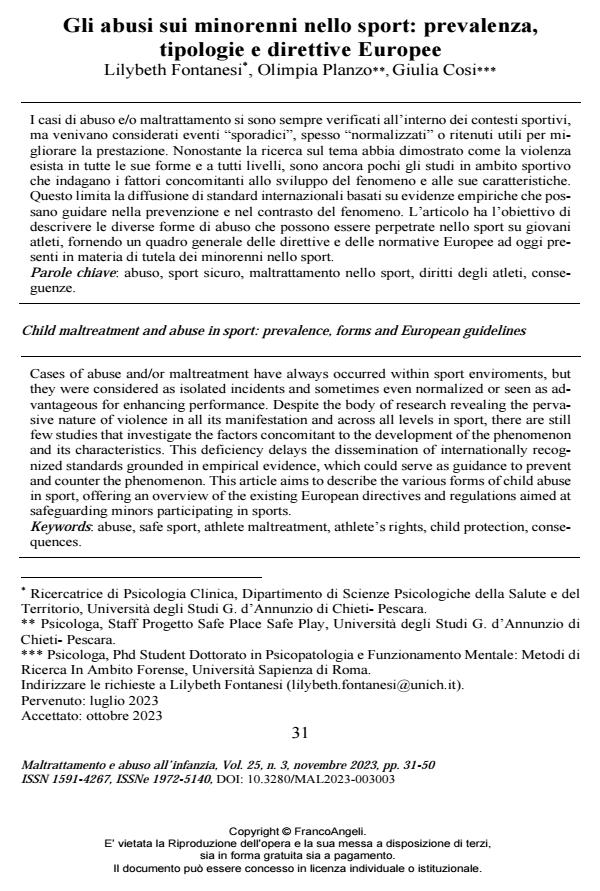Gli abusi sui minorenni nello sport: prevalenza, tipologie e direttive Europee
Titolo Rivista MALTRATTAMENTO E ABUSO ALL’INFANZIA
Autori/Curatori Lilybeth Fontanesi, Olimpia Planzo, Giulia Cosi
Anno di pubblicazione 2024 Fascicolo 2023/3
Lingua Italiano Numero pagine 20 P. 31-50 Dimensione file 207 KB
DOI 10.3280/MAL2023-003003
Il DOI è il codice a barre della proprietà intellettuale: per saperne di più
clicca qui
Qui sotto puoi vedere in anteprima la prima pagina di questo articolo.
Se questo articolo ti interessa, lo puoi acquistare (e scaricare in formato pdf) seguendo le facili indicazioni per acquistare il download credit. Acquista Download Credits per scaricare questo Articolo in formato PDF

FrancoAngeli è membro della Publishers International Linking Association, Inc (PILA)associazione indipendente e non profit per facilitare (attraverso i servizi tecnologici implementati da CrossRef.org) l’accesso degli studiosi ai contenuti digitali nelle pubblicazioni professionali e scientifiche
I casi di abuso e/o maltrattamento si sono sempre verificati all’interno dei contesti sportivi, ma venivano considerati eventi “sporadici”, spesso “normalizzati” o ritenuti utili per migliorare la prestazione. Nonostante la ricerca sul tema abbia dimostrato come la violenza esista in tutte le sue forme e a tutti livelli, sono ancora pochi gli studi in ambito sportivo che indagano i fattori concomitanti allo sviluppo del fenomeno e alle sue caratteristiche. Questo limita la diffusione di standard internazionali basati su evidenze empiriche che possano guidare nella prevenzione e nel contrasto del fenomeno. L’articolo ha l’obiettivo di descrivere le diverse forme di abuso che possono essere perpetrate nello sport su giovani atleti, fornendo un quadro generale delle direttive e delle normative Europee ad oggi presenti in materia di tutela dei minorenni nello sport.
Parole chiave:abuso, sport sicuro, maltrattamento nello sport, diritti degli atleti, conseguenze.
Lilybeth Fontanesi, Olimpia Planzo, Giulia Cosi, Gli abusi sui minorenni nello sport: prevalenza, tipologie e direttive Europee in "MALTRATTAMENTO E ABUSO ALL’INFANZIA" 3/2023, pp 31-50, DOI: 10.3280/MAL2023-003003